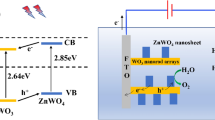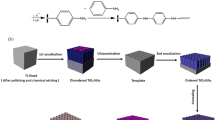Abstract
In this study, we have fabricated network-like Au/ZnO nanowire arrays with special space structure using a simple photo-reduction method. The morphology and photoelectrochemical property of the network-like Au/ZnO nanowire arrays could be controlled by changing the reaction parameters such as the photo-reduction time and concentration of reagents. Moreover, their photoelectrochemical and supercapacitor performances have also been performed, revealing that the network-like Au/ZnO nanowire arrays possesses a much higher photocurrent density than the pure ZnO nanowire arrays. The enhanced photoelectrochemical performances could be originated from the surface plasmon resonance within Au nanostructure and the special space structure of network-like Au/ZnO nanowire arrays.
Graphical Abstract
The network-like Au/ZnO nanowire hetero-arrays electrodes have been fabricated by a facile photo-reduction method. Benefiting from the special reticular structure, network-like Au nanorods/ZnO nanowire arrays (Au NR/ZnO NWA) has a much higher photocurrent density and specific capacitance than that of ZnO nanowire arrays (ZnO NWA) and Au nanoparticles/ZnO nanowire arrays (Au NP/ZnO NWA). The enhanced PEC and supercapacitor properties have also been investigated detailedly.






Similar content being viewed by others
References
Bae J, Song M, Park Y, Kim J, Liu M, Wang Z (2011) Angew Chem Int Ed 50:1683–1687
Khaselev O, Turner JA (1998) Science 280:425–427
Hoffmann MR, Martin ST, Choi W, Bahnemannt DW (1995) Chem Rev 95:69–96
Futaba D, Hata K, Yamada T, Hiraoka T, Hayamizu Y, Kakudate Y, Tanaike O, Hatori H, Yumura M, Iijima S (2006) Nat Mater 5:987–994
Zhang Y, Li H, Pan L, Lu T, Sun Z (2009) J Electroanal Chem 634:68–71
Linic S, Christopher P, Ingram D (2011) Nat Mater 10:911–921
Osterloh FE (2013) Chem Soc Rev 42:2294–2320
Kronawitter CX, Vayssieres L, Shen S (2011) Energy Environ Sci 4:3889–3899
Xu F, Lu Y, Sun L, Zhi L (2010) Chem Commun 46:3191–3193
Ryu J, Lee SH, Nam DH, Park CB (2011) Adv Mater 23:1883–1888
Mclaren A, Valdes-Solis T, Li G, Tsang SC (2009) J Am Chem Soc 131:12540–12541
Wang T, Jin BJ, Jiao ZB, Lu GX, Bi YP (2014) J Mater Chem A 2:15553–15559
Dr A, Leung Y (2006) Small 2:944–961
Zhao W, Ma W, Chen C, Zhao J, Shuai Z (2004) J Am Chem Soc 126:4782–4783
Baker D, Kamat P (2009) Adv Funct Mater 19:805–811
Seol M, Kim H, Tak Y, Yong K (2010) Chem Commun 46:5521–5523
Kongkan A, Tvrdy K, Takechi K, Kuno M, Kamat P (2008) J Am Chem Soc 130:4007–4015
Pu YC, Wang G, Chang KD, Ling Y, Lin B (2013) Nano Lett 13:3817–3823
Chiarelloa G, Aguirreb M, Sellia E (2010) J Catal 2010(273):182–190
Chen X, Shen S, Guo L, Mao S (2010) Chem Rev 110:6503–6570
Gong J (2012) Chem Rev 112:2987–3054
Hou W, Cronin SB (2013) Adv Funct Mater 23:1612–1619
Zhang X, Liu Y, Kang ZH (2014) ACS Appl Mater Interfaces 6:4480–4489
Chen CK, Chen HM, Chen CJ, Liu RS (2013) Chem Commun 49:7917–7919
Zhang Z, Zhao B, Hu L (1996) J Solid State Chem 121:105–110
Pastoriza-Santos I, Liz-Marzán LM (2002) Langmuir 18:2888–2894
Tian C, Zhang Q, Wu A, Jiang M, Liang Z, Jiang B, Fu H (2012) Chem Commun 48:2858–2860
He W, Kim H, Wamer W, Melka D, Callahan J, Yin J (2014) J Am Chem Soc 136:750–757
Wang T, Lv R, Zhang P, Li C, Gong J (2015) Nanoscale 7:77–81
Liu L, Ouyang S, Ye J (2013) Angew Chem 125:6821–6825
Zhang L, Zhao X (2009) Chem Soc Rev 38:2520–2531
Acknowledgments
This work was supported by the “Hundred Talents Program” of the Chinese Academy of Science and National Natural Science Foundation of China (21273255, 21303232).
Author information
Authors and Affiliations
Corresponding authors
Electronic supplementary material
Below is the link to the electronic supplementary material.
Rights and permissions
About this article
Cite this article
Jin, B., Wang, D., Feng, C. et al. Facile Fabrication of Network-Like Au/ZnO Nanowire Hetero-Arrays for Improved Photoelectrochemical and Supercapacitor Properties. Catal Lett 146, 1348–1354 (2016). https://doi.org/10.1007/s10562-016-1763-0
Received:
Accepted:
Published:
Issue Date:
DOI: https://doi.org/10.1007/s10562-016-1763-0




